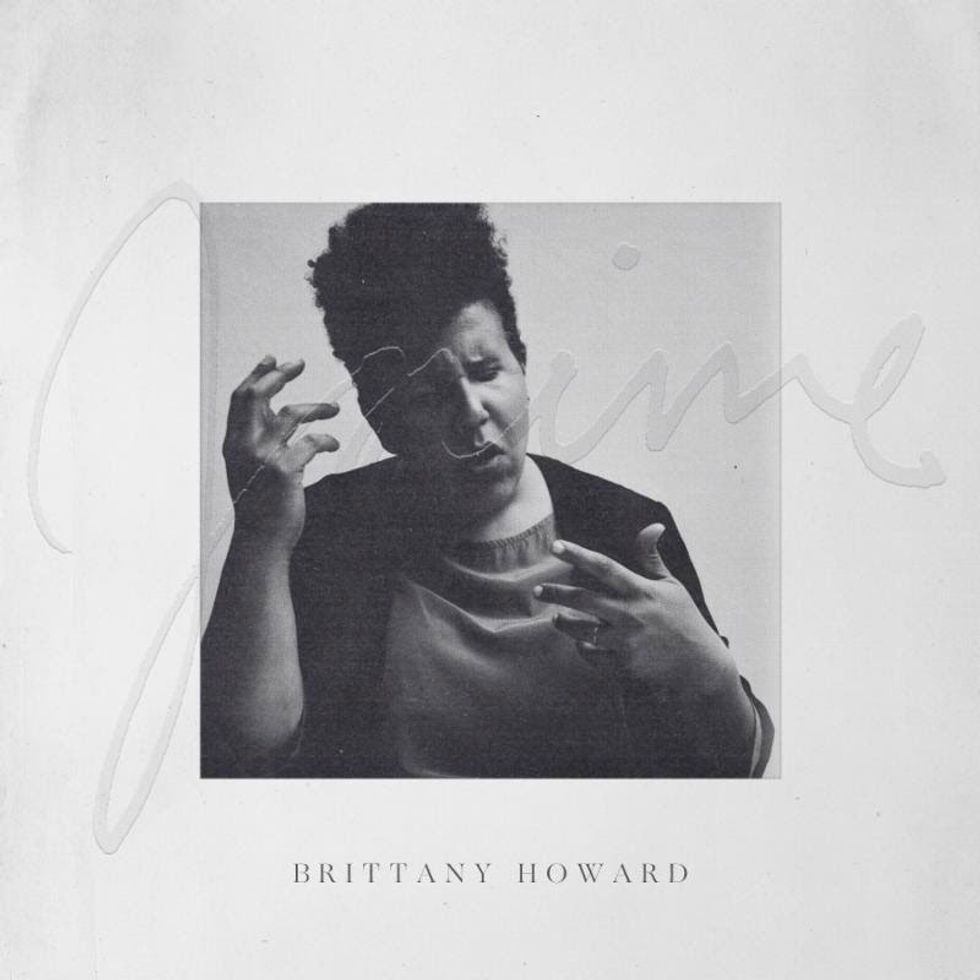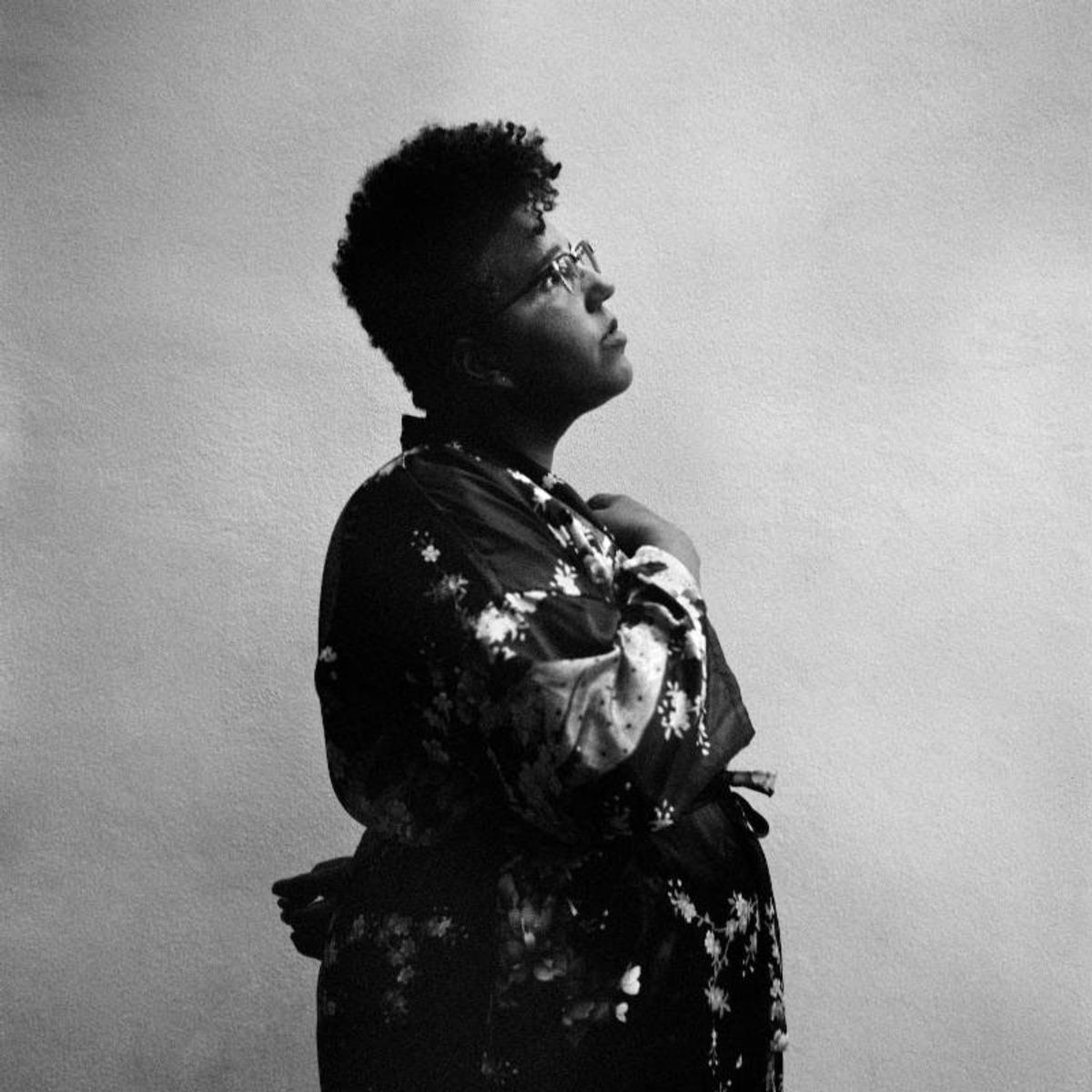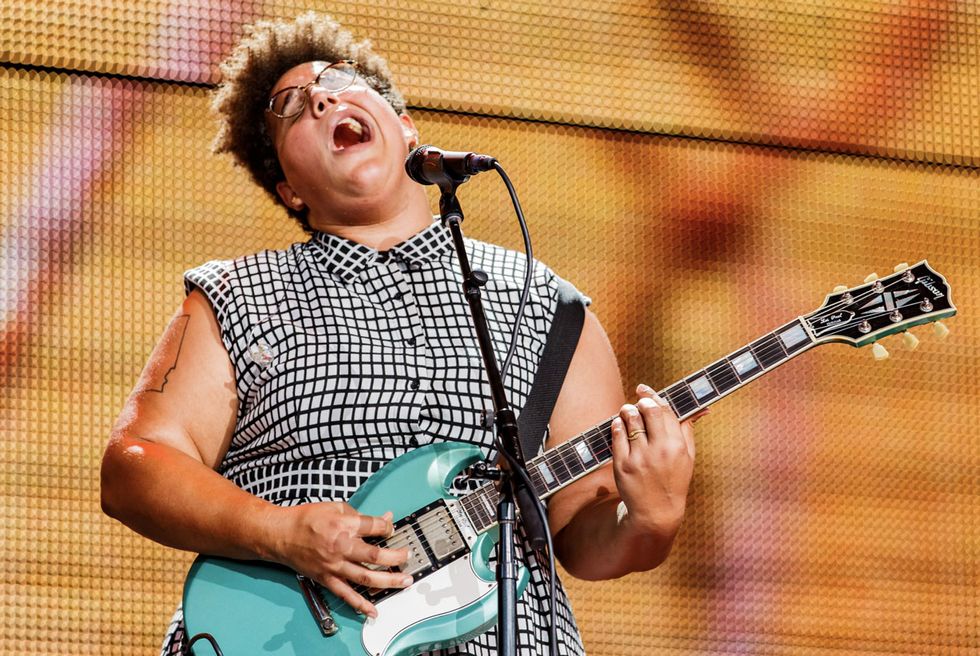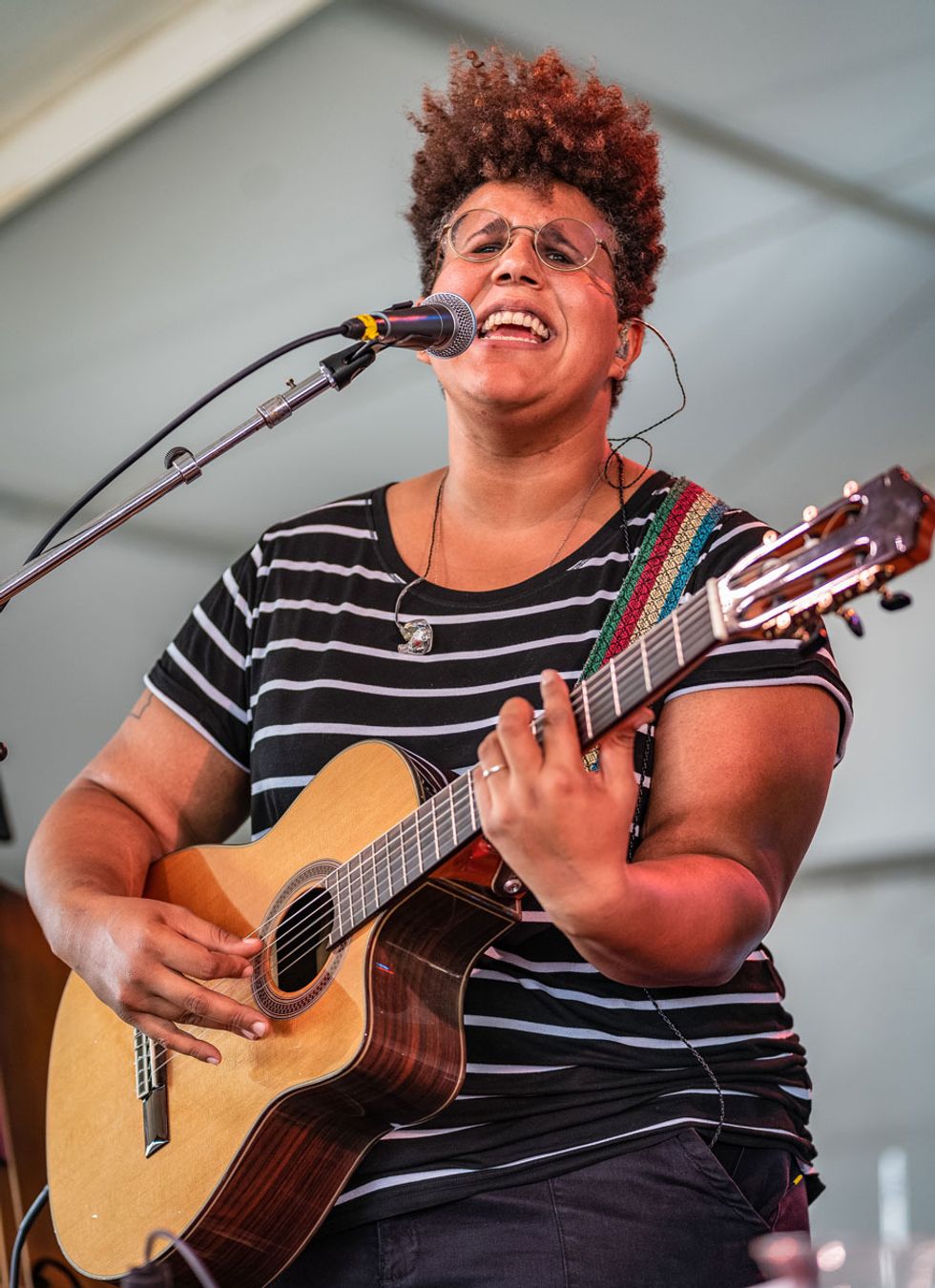The Alabama Shakes siren breaks out on her own with Jaime—a visceral solo album on which she uses a broken Japanese guitar and a laptop to explore the deep dance between heartbreak and happiness.
As the frontwoman and principal songwriter of Alabama Shakes, Brittany Howard’s songcraft and soulful voice are the driving forces behind one of the most revered bands of the last decade. The Shakes’ Blake Mills-produced 2015 release, Sound & Color, was a swirling, psychedelia-tinged slab of soul, blues, and primordial rock ’n’ roll, which debuted as a Billboard No. 1, netted the quartet a grip of Grammys, and heralded their arrival as one of the most vital groups of their generation.
The marathon of touring which followed the success of Sound & Color left Howard drained, afflicted by writer’s block, and in need of a break from the behemoth which Alabama Shakes had become. Making the decision to step away from the group, Howard went about the work of rediscovering herself as a person and a songwriter. Now, with the release of Jaime, the chanteuse has reemerged as a fully fledged solo artist.
Thematically, Jaime is a viscerally human affair. Howard says writing the record served as “a process of healing” and that certainly comes through. The album’s title pays tribute to Howard’s late sister—a musician herself who tragically passed away as a teenager after fighting a rare form of cancer—and its songs were each written in an attempt to confront emotional specters, demons, or situations beyond Howard’s control. It’s a starkly personal and revealing album.
However, despite the record’s formidable pathos, Howard’s playful energy often pokes through its clouds. After all, this is the work of a woman whose extracurriculars include fronting a campy garage-rock project called Thunderbitch, with whom she once performed donning whiteface, a black bob wig, and mounted atop a motorcycle which had been planted dead center on the comically small stage of a Brooklyn club.
To that end, Jaime’s heavy topics float upon buoyant melodies, drown in deep grooves (further accentuated by drummer Nate Smith’s mega performance), and are often juxtaposed against sweet sonics. Questions of faith are channeled into a greasy “anti-gospel” banger in “He Loves Me.” The trauma Howard experienced as an interracial kid growing up in the deep South are pumped into a head-bob-inducing, hip-hop bounce on “Goat Head.” The wide spectrum of feelings being in love can evoke are explored through the neo-soul grooves of “Presence” and sparse, intimate ballads like “Short and Sweet.” Yeah, for an ostensibly dark record, Jaime not only has range. It slaps!
Lurking at the core of Jaime’s songs lies Howard’s criminally overlooked guitarwork. She prefers to frame her relationship to the instrument as a means to an end for songwriting, remarking “it’s just the instrument that I know the most about.” But Howard’s distinctive voice as a guitarist played a major role in shaping Alabama Shakes’ sound and Jaime is no different. The record boasts miniature guitar orchestras that lock into funky, deceptively tricky rhythms, and outbursts of emotional, downright molten lead playing, and Howard’s guitar often provides a perfect dance partner for her vocals, with the two gracefully shadow-boxing throughout the album. While Howard might object to the fanfare, there are guitar moments sprinkled throughout Jaime’s effortlessly cool songs that point to the work of a masterfully expressive 6-string stylist, like the avant-garde guitar conversation that happens during the tail end of “Presence” or the burning solo that cuts through “He Loves Me.” And all of this is made even more impressive by the fact that most of the guitar tracks which appear on the album’s final mix were pulled directly from the home demos Howard recorded with a literally broken, unbranded, vintage Japan-made guitar into a laptop loaded with Logic.
Premier Guitar spoke with Howard by phone as she unwound at home following a short promo tour for the release of Jaime. While we were delighted to be granted some insight into Howard’s approach as a songwriter, the conversation delved much deeper into the mind of Brittany Howard the guitarist, a player who celebrates the influence of people like Queen’s Brian May and Dave Davies as much as rock ’n’ roll pioneers like Sister Rosetta Tharpe and Chuck Berry.
Jaime does a really remarkable job of tackling heavy topics through joyful-sounding tunes.
Yeah! I always like juxtaposition because it makes everything richer. Life is all about juxtaposition: You’ve got happiness, sadness, comedy, death—everything is always juxtaposed next to something. I find it enjoyable making beautiful music about sad topics and vice versa. It makes you listen a little differently, you know?
The rhythm guitar parts on “He Loves Me” are really cool and the track really shows off your strengths as a rhythm player. Could you break down the construction of that one?
There are like seven guitar parts on that one. I didn’t want to play anything totally straightforward on that one, and that’s where it started. I asked myself, “If I do this rhythm line as the backbone that all the chords follow, how do I end up in an unexpected place?” That’s basically the inspiration and intention behind all of my guitars parts; finding a way to make things a little bit off-kilter. I listen to a lot of classical music and I love those big rises and falls and dynamic shifts and I like to compose guitar that way. One of my favorite guitar players is Brian May of Queen. I always liked how he stacked up everything and could make something really rich and soaring sounding just through his note choices and an orchestral approach.

Brittany Howard named her solo debut after her older sister, Jaime, who died from retinoblastoma, a rare form of eye cancer, at the age of 13. Brittany was also born with the disease, which left her partially blind in one eye.
The solo on that track gives me some serious Mick Ronson or Prince vibes and manages to feel both off-the-cuff, but also perfectly composed for the tune.
That solo was actually something I did on the demo. I didn’t re-record it for the album. I just wanted something that was blazingly hot and in-your-face, and that just felt like the right thing for the song. It had the right kind of dirt and the right kind of attitude. I usually don’t put guitar solos in songs because it always comes down to asking myself, “What are they doing there?” But that song is a weird gospel/anti-gospel song and I asked myself what was something I’d never hear at church when I played that solo.
Do you recall what you were using for that fuzz sound?
I had a ton of fuzzes on that. I know I was using both a fuzz and an overdrive stacked on that solo, and I used this old Japanese-made, probably Teisco guitar. I can’t recall exactly which fuzz or overdrive, but I was using a very little speaker and I remember it was a stack.
Is the Teisco guitar that sunburst four-pickup model you’ve been using live lately?
Yeah, that’s the one. I played that guitar on everything on the record. I just kind of stuck to it for some reason. At the time I was recording, the neck was actually broken and seriously tilted, but for some reason I really enjoyed the way it made me play. It made me play in a different way and I was excited to hold the guitar because it was very imperfect. I can’t quite explain why, but it was very inspiring.
I think a lot of players secretly prefer what comes out of an instrument that’s fighting them. It forces you to feel more than you think.
Yeah, exactly! When I have a guitar that’s so slick, I just don’t play the same. It’s true that every guitar has its own songs in it and brings out different things. That particular Japanese guitar has so many tonal options with that many pickups and switches, and I’m not even sure if they’re all functioning correctly, but there are so many different sounds I can get out of it. I think that’s also why I stuck to it so much. I think it’s a Teisco even though it doesn’t have a name on it. I found it at a pawnshop and just thought it looked really cool.
I’ve read that you tracked a lot of the album at home in Logic. Did you rely on miked amps or were you using amp sims for much of it?
I was doing a bit of both. Like the solo on “He Loves Me” ended up getting reamped and thrown through some real pedals, but all of the ideas always came from software amps.
What were your go-to choices for real amps and reamping?
It was a little haphazard. I know we used a little Gibson combo amp a lot and we used an old Music Man a lot for clean stuff. That one had a really great, warm clean tone and I used it a lot on the track “Baby.”
“I always wanted that guitar and I always thought it was the one for me,” says Brittany Howard of her 1961 Gibson SG Custom. “I don’t like Les Pauls because they’re too heavy and I was just never really around Fenders.” Photo by Matt Condon
One of your calling cards as a guitarist is riffs that are really deep in a rhythmic pocket, but deceptively tricky. Do you have a specific approach to writing those rhythmic, riffy ideas?
To me, it’s pretty simple: It just has to feel good. It has to make me want to play it again and you have to enjoy playing it—it can’t be tedious or annoying. I’m really feel based, and it has to connect to a part of you that feels right. When something doesn’t feel right, it’s definitely not good. For example, something like “Don’t Wanna Fight” started as a pretty standard funk thing, but then I asked, “How can I take this and orchestrate it in a way that reminds me of [jazz and soul producer] David Axelrod?” It has to be both simple and off-kilter at the same time. Simple enough to work, but different than what people are expecting and used to hearing.
You’ve said in the past that you don’t have aspirations to master the guitar or conquer the technical side of the instrument, but you’re obviously very passionate about it and it’s a major part of what you do as a musician.
I definitely don’t want to master the instrument; it’s just the instrument that I know the most about. When I sit down with a guitar, I like to approach it like I’ve never played guitar before, you know? It’s more exciting for me not to know everything because I feel like if I knew everything, I’d definitely be bored and I’d come up with stuff that makes too much sense, and I doubt I’d like what came out. I like not knowing what’s going on or what I’m doing and the mystery of sounds.
Things can get very clinical for players that are also songwriters when they know too much.
I don’t necessarily want a great understanding of music, but it obviously depends on what your goals are. For me, it’s just a means to get this stuff out of myself and it’s about pure creativity. When I pick up the guitar, I think, “what’s something I’ve never done before?” or “what’s something I don’t understand?” or “what’s something I’ve never heard?” and I try to start there. It’s all about finding a fresh place, or at least a fresh place to myself. I start getting really bored of the instrument when I start linking too much of it together and start thinking about things like the circle of fifths and all of that.
Are there any guitarists that you found inspiration in while writing this album?
I really like the way Dave Davies plays. He’s always been one of my favorite guitar players and I love how he can be really raucous and noisy, but also really technical and beautiful. I’m also really into Chuck Berry and I just love the way he played guitar. I always thought of Chuck Berry as the pinnacle of rock ’n’ roll, and that his stuff was when rock ’n’ roll was at its best and most vital.
You’ve been an outspoken fan of Sister Rosetta Tharpe’s for quite a while and a lot of people argue that Chuck Berry stole his best moves from her.
Well she created rock ’n’ roll, that’s for sure! I think it’s so exciting that people are finally finding out and talking about her. Her personal life was crazy, too! There’s a great book about her I read called Shout, Sister, Shout! and she was absolutely rock ’n’ roll before rock ’n’ roll was happening! I think Sister Rosetta just understood a lot of things about performing and being a performer, but also coming out of the gospel world and singing like that, having that niche as a female guitar player—what’s not to love? Her songs were good, too. My favorite thing is just watching her play and she did it for so long that it wasn’t even work to her. It just seemed so effortless.
I was surprised to find out that the green Gibson Les Paul SG Custom that you use found its way into your life by accident rather than being a nod to the white SG Sister Rosetta used.
Yeah! I didn’t even know about Sister Rosetta when I chose that guitar, but I always wanted that guitar and I always thought it was the one for me. I don’t like Les Pauls, because they’re too heavy, and I was just never really around Fenders, so I didn’t really know much about them. What happened was that Heath [Fogg, guitarist of Alabama Shakes] let me borrow his SG because I didn’t have a guitar to play at the time and that’s where it all began. I kept playing his SG and then I saw the one with three pickups and was like “whoa!” And then I saw the white one Sister Rosetta used. Now I’ve got like five of ’em! I use .010s on all of my guitars and I just keep that middle pickup out of the way a little. I tilt the pickups so that they’re higher under the low strings so they get a little more growl to them.

Guitars
1961 Gibson Historic Les Paul SG Custom
Unbranded Japan-made four-pickup guitar (possibly Teisco)
Amps
’70s Semprini ST280-20/M Tube PA
’70s Semprini BF 110 16-ohm cabs
Vintage Music Man combo
Vintage Gibson combo
Effects
Electro-Harmonix Big Muff
Roland RE-201 Space Echo
Boss RE-20 Space Echo (backup)
ZVEX Mastotron
Boss FRV-1 ’63 Fender Reverb
Boss TU-3 Tuner
Strings and Picks
.010–.046 gauge strings
Dunlop Tortex .73 mm picks
The guitar accompaniment and interplay with the vocal melody on “Short and Sweet” is really beautiful. Do you typically think of a vocal melody before or after a guitar idea?
That song in particular started with that opening chord. I don’t know what that chord is called, but it sounded to my ears equally happy and sad. I was like “Whoa! Cool chord!” and then I dropped it down to a G and rolled with it from there. When I was constructing that song, it was both of those ideas at the same time, and that song was really about finding a balance between sadness and happiness. I think that combination inspires great love songs because isn’t that what love is?
There’s a cool guitar drone in the right speaker of “13th Century Metal” and there’s a lot of cool atmospherics like that on the album. How do you approach adding that stuff into your songs?
I listen to what we had a bunch of times and I said, “You know what’s missing? Some doom and gloom.” At the end of that song I really wanted you to feel like you’re entrenched in chaos and confusion, and you have to be overwhelmed, so that gave purpose to adding those metal-sounding guitars at the end. I really needed the end to be bombastic.
Sometimes you have to be careful not to add too much, but it all depends on the song. For that song, I felt it needed too much because there was already so much there and it called for it. Songs like “Short and Sweet” don’t need any production because I think it would take away from the song.
The guitar conversation in the solo section at the end of “Presence” is another great example of how you use the guitar to add color and drama without relying on typical ideas.
Yeah, I just hate the idea of being boring. With that one, I was trying to think of a solo and everything I tried wasn’t right. Then I just said, “Let’s get weird” and did a three-part harmony solo specifically out-of-time, and thought, “This is cool!” It worked!
You seem very comfortable with embracing weirdness while making it approachable.
Getting weird is literally my favorite thing to do! I had songs so weird they didn’t make it onto the record. Like Brian Wilson weird, but I don’t think they would’ve been enjoyable to listen to on the record. But they’re fun!
You worked closely with Blake Mills with Alabama Shakes. There’s no denying that Blake’s become one of the most influential producers and guitarists working today. What did you learn from that experience as a player?
The whole reason I wanted to work with Blake is his attention to detail and the fact that he realizes that everything matters. Details matter to him. Blake leaned into carving out the things that shouldn’t really be on a track and is great about asking questions like “why is that there?” and pointing those things out. It was details like octave range and figuring out that if something is in a different octave, it leaves more space for other sounds.
I definitely get the Blake thing: He’s probably the best guitar player I’ve ever encountered. That said, I suppose I don’t really try to be like anybody when it comes to music. It’s funny to be doing an article about playing guitar, because I use the guitar as a means to an end. I don’t think of guitar the way a lot of guitarists do. It’s really just the instrument that I can play the best and I’m trying to paint out my ideas with it. That might explain why some of my compositions are a little odd or off-kilter. That’s also what makes me excited about the instrument: I like to see how far away I can get from making such “guitar part” music.
Which I think at its best works to the opposite effect, because it makes for unexpected and interesting guitar parts that people then want to analyze!
Oh God, I wish I could send you the guitar stems from this record, you’d be like, “what the fuck?!”
Brittany Howard performs on acoustic guitar in one of her side projects, the alt-country band Bermuda Triangle, during the 2018 Newport Folk Festival. Photo by Douglas Mason
How far from the demos did the guitar parts travel on this record?
Literally all of the guitar parts on the record except for “Presence” are from my demos. I just had it in the moment for some reason.
It’s inspiring that an artist with your success is still down to create at home with very basic tools that almost anyone can afford.
I’d really encourage people not to get caught up in the trap of expensive gear and expensive studio time. If you have a mind to do it, you can do it. I wish I’d known that when I was younger because when you’re a teenager, you want all of the gear. You want a full stack because you think that’s going to make you a better guitar player, but it’s a waste of money! I talked my dad into getting me an Ibanez half-stack, because that’s what he could afford, but when he went to the music store, they gave him the full stack by mistake. I don’t think my dad had ever seen me that happy! I would practice in the room next to his bedroom and he was really cool about it, man. I would play until like 11 at night and he’d just be like “Alright Brittany, that’s enough.” It’s a good feeling playing through something like that, then walking away from it and coming back to it. I totally remember that feeling.
Speaking of, let’s talk amps a bit more. I’ve seen a pretty arcane-looking amp rig behind you onstage lately. What is that thing?
It’s not a guitar amp at all. It’s actually an old Italian PA. I was looking for a tube PA because I really like the way tubes sound and I really hate the way most new PAs sound, like the typical ones you can buy at a guitar store to practice with. So I thought, how cool would it be if I sang out of a tube PA? I found this ’70s Semprini [ST280-20/M] and had to get it doctored up a little bit because the inputs and outputs are all different, and I plugged a guitar into it one day and it was killer, so it became my guitar amp.
Could you describe what the raw tone of it is like?
I’ve never heard anything exactly like it before. It’s shockingly clear and everything is very distinct. It never gets too muddy, but it still has a lot of growl and when you really lay into your guitar, it becomes kind of twangy. It never really breaks up, and because it has such big speakers you get a lot of bass out of it. I run two identical Semprini [BF 110 16-ohm] cabs with it and they have a 15 and a giant tweeter—it’s crazy in there. You can’t really find them. I’ve only found the one and I looked for forever! But Natalie [Hernandez], my guitar tech, actually tracked down and called the son of the guy that made them and he has one and I’m buying that one, too.
You’re also running a Roland Space Echo live these days and I’m curious how that effect came into your life and how you’re using it?
The cool thing about those Roland Space Echos is they all sound different and they all have their own quirks. The one I have made my amp sound even cooler and colored the tone in a great way. Tape tends to do that, but it made my amp sound a bit glassy, twangy, and even bumps the bass a little. So I like it almost more for what it does to my tone and the way my guitar sounds when it hits that tape and comes out of the other side sounding amazing. I feel like I’m doing analog equalizing with it.
Did any other effects play a major role on the album?
I don’t use a lot of pedals and I never have. I think that started from not being able to afford them, so I missed that thing where teenagers get dumb and think having more pedals makes you cooler. So I usually just run an overdrive and I always have a Big Muff and a tuner and that’s pretty much my whole setup. The Big Muff is a new one and all I need it to do is sustain my notes.
Any advice for women as guitar culture continues to shift away from the boys club it’s typically been?
When women play instruments, for some reason it feels and sounds different than when men do. Not all the time, but I do notice when women play guitar, I’m a little more curious about what they’re about to say with it. It’s not what you’d expect a lot of the time and I really enjoy that. Someone like St. Vincent, who writes guitar parts that are so cool, man! Her choices as a musician are cool and I’d tell young female guitar players to look up to people making their own choices and not just playing to be technically amazing. There’s a lot of creativity that goes into playing and you shouldn’t shun that side of yourself, or that freedom to be what the establishment defines as technically the “best.”
In this live session, Brittany Howard and her killer band blaze through a smoking rendition of “He Loves Me.” Check out her new favorite guitar, a Japanese pawnshop discovery with four pickups.
This full concert of Brittany Howard performing songs from Jaime was recorded at the Palace Theatre in St. Paul, Minnesota, the night before her album release.




